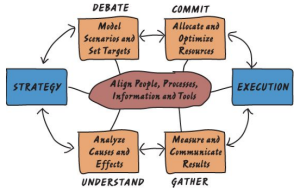I would like to introduce a framework for thinking about Enterprise Performance Management and Business Intelligence. The genesis of this framework came from my days working at Hyperion Solutions (later acquired by Oracle Corp.). It’s been called a management “operating system” for your company because, like the operating system of your computer, it helps govern input and output and manage what applications (or decisions) are being run and helps make the most effective use of resources (memory, disk space, CPU cycles). You can start anywhere on this closed-loop process to tell the management operating system story, and today I’ll share Gather – the most common part of the cycle, with you.

A Management Operating System
Gather – While you are busy running your business (Execution, which means service customers, making products, selling in markets), you are generating lots of data. You gather that data and transform it into useful information (according to its context) and deliver it to the right people (according to impact and areas of responsibility).
This is the place where managers consume reports about the results of the business. It’s where they answer the question “where are we, right now?” Depending on your industry and your business, there are generally two kinds of reports: mostly financial and mostly operational. The trend has been to combine financial and operational information on one report, which is a good idea since the two are interrelated: financial investments help drive operational results, and effective operations help contribute to financial performance.
Reports are delivered in a variety of formats with a variety of tools and can be categorized as:
- Canned (static) reports
- Ad hoc or interactive reports
- Dashboards and scorecards
- Spreadsheets
Reports give their readers a snapshot of what results have been produced to date to help them gauge how close to their goals and targets they are.
You can learn more about EPM and how it can help your organization build a common business process to execute its strategy in my book Enterprise Performance Management Done Right: An Operating System for Your Organization (Wiley CIO)



